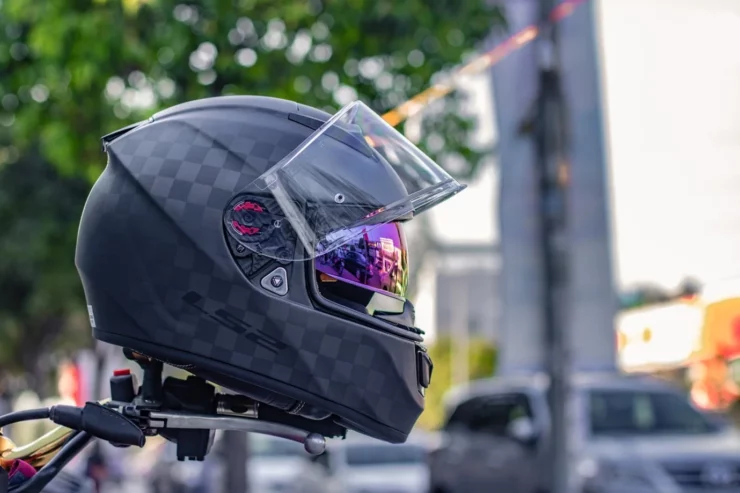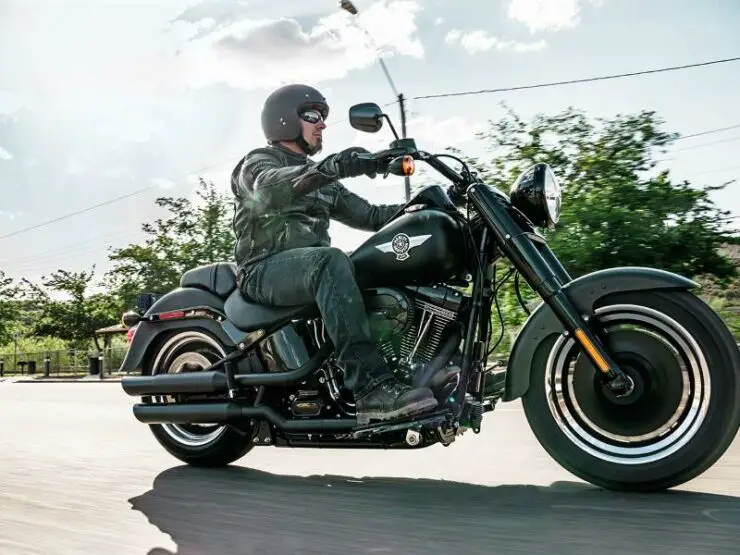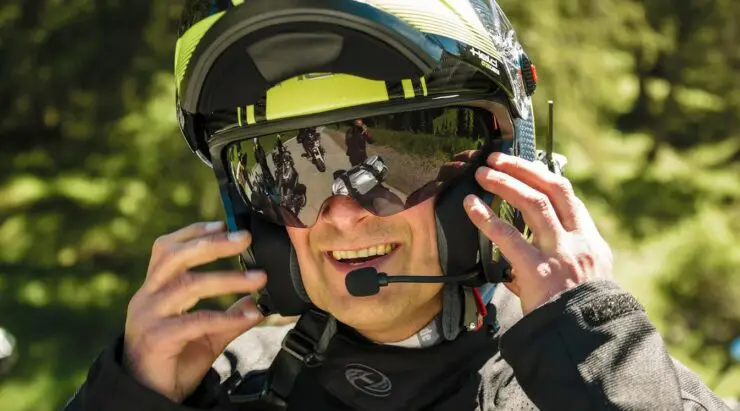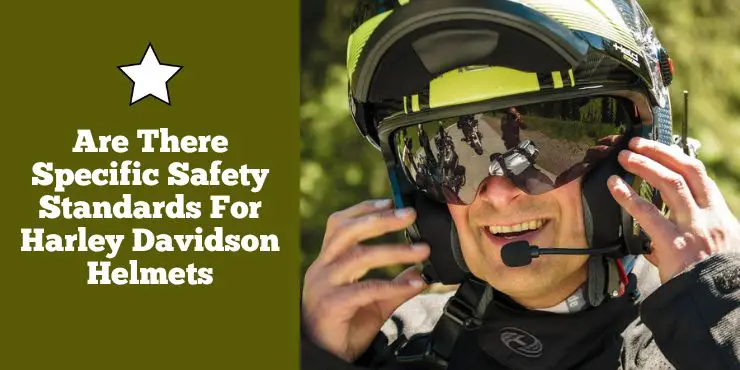Are you considering purchasing a Harley-Davidson helmet for your next ride? Are you curious about the safety standards for this type of helmet? Look no further!
Yes, helmets for Harley-Davidson should meet DOT, ECE, or Snell safety standards, which verify impact resistance, retention, and durability.
This article will provide a comprehensive overview of what you need to know about the safety standards for Harley-Davidson helmets. From the materials used to the certifications required, read on to learn more about the safety specifications and features of these protective headgear. By the end of this article, you will have a better understanding of the safety standards for Harley-Davidson helmets and be able to make an informed decision when you purchase one for your next ride. So, let’s get started!
Overview of Harley-Davidson Helmets
When it comes to riding a Harley-Davidson bike, the thrill of the open road and the freedom it offers are part of the allure. However, it is important to prioritize safety and protect yourself while enjoying the ride. Helmets play a key role in ensuring the well-being of Harley-Davidson motorcyclists, providing essential protection in the event of accidents or unexpected incidents.
>>> Click here to read our review of the Best Helmet For Harley-Davidson <<<
A helmet is a protective headgear designed specifically to reduce the risk of head injuries during motorcycle rides. It typically consists of a hard outer shell made from materials like fiberglass or polycarbonate, an impact-absorbing liner, and a chin strap to keep it securely in place. Helmets come in different designs, including full-face, open-face, and half-shell helmets, providing different levels of coverage and protection.
The importance of wearing a helmet while riding a Harley-Davidson bike cannot be overstated. There are many reasons why helmets are so important such as protection in case of accidents, shielding from debris and elements, enhanced visibility, wind noise reduction, and more.
Helmets are specifically designed for absorbing the impact of a crash and protecting the head from injuries. In the event of an accident, a helmet will significantly reduce the risk of severe head trauma, skull fractures, or brain injuries.
When riding a Harley, bikers are exposed to various environmental elements, such as flying debris, dust insects, and adverse weather conditions. A helmet will provide a barrier, keeping the rider’s face and head protected from these external elements, ensuring clear vision and minimizing distractions.
Many modern helmets come with features like reflective strips or built-in LED lights, improving visibility for both the rider and other vehicles on the road. This can be particularly crucial during low-light conditions or when riding at night, making the biker more noticeable and reducing the risk of accidents.
Riding at high speeds on a Harley-Davidson bike can result in significant wind noise, which can cause fatigue and affect the rider’s concentration. Helmets with proper padding and design help reduce wind noise, ensuring a more comfortable and focused riding experience.
Helmets play different important roles in the life of a Harley-Davidson biker. Some of them include providing safety, expressing personal expression, compliance with legal requirements, and more. The key role of a helmet is to protect the rider’s head and minimize the risk of severe injuries. By wearing a helmet, the Harley-Davidson biker will be able to prioritize their safety and well-being, ensuring they can continue enjoying the freedom of the ride with peace of mind.
Helmets offer bikers an opportunity to showcase their personal style and individuality. With different designs, colors, and customizations available, bikers will be able to choose helmets that reflect their personality while still prioritizing safety.
In many jurisdictions, wearing a helmet while riding a bike will be legally mandated. By adhering to these regulations, Harley-Davidson bikers will avoid legal consequences and fines. Moreover, these rules demonstrate a responsible attitude towards road safety.
Harley-Davidson bikers often serve as role models within the motorcycle community. By consistently wearing helmets, you’ll be able to set a positive example for others and promote a culture of safety, encouraging fellow riders to prioritize their well-being.

Are there any specific safety standards for Harley-Davidson helmets?
When it comes to riding a Harley-Davidson bike, safety will be of utmost importance. In fact, it needs to be your top priority. One of the most important safety measures for any biker will be to wear a helmet when driving. To guarantee the effectiveness of helmets in protecting riders, rigorous standard testing procedures and other safety standards are important factors that motorcycle helmet brands uphold. Harley-Davidson understands that a helmet’s safety features go beyond impact resistance and durability, which is why these helmets are in a class of their own. Here are the safety features and standards that are crucial for Harley-Davidson helmets.
#1. Standard testing procedures for Harley-Davidson helmets
Harley-Davidson recognizes the importance of ensuring that its helmets meet rigorous safety standards. Helmets manufactured by Harley-Davidson adhere to various international safety standards, including those set by organizations like the Department of Transportation (DOT), The Economic Commission of Europe (ECE), and the Snell Memorial Foundation, among others.
These safety standards need helmets to undergo extensive testing to assess their effectiveness in protecting the rider’s head in various scenarios. Some of the key aspects evaluated during standard testing procedures include impact resistance, penetration resistance, retention system strength, the field of vision, and chin strap durability. Helmets need to pass these tests to receive certification, indicating their compliance with safety standards.
By adhering to these safety standards, Harley-Davidson ensures that its helmets offer a high level of protection and meet or exceed the safety requirements set by regulatory bodies. It is important to note that even with adherence to safety standards, helmet effectiveness can be greatly influenced by factors like proper fit, correct usage, and regular maintenance. Riders should always follow manufacturer guidelines and replace helmets after an impact or if they show signs of damage or wear.
#2. Durability and impact resistance
Durability is an important factor in helmet safety. Harley-Davidson helmets are designed for withstanding the demands of motorcycle riding, which exposes riders to various environmental conditions and potential impacts. The helmets undergo rigorous to ensure that they are durable and can withstand daily wear and tear.
Manufacturers typically use robust materials such as fiberglass, polycarbonate, or composite shells to provide strength and impact resistance. The construction of helmet’s shell and internal components are meticulously engineered to maintain structural integrity and protect the rider’s head in the event of a crash or impact.
Another critical safety feature of a helmet is its ability to absorb and dissipate the force of an impact. Harley-Davidson helmets are designed to provide excellent impact resistance to minimize the risk of head injuries. This is achieved through a combination of the helmet’s outer shell and the impact-absorbing liner.
The outer shell of a Harley-Davidson helmet is constructed using durable materials that are capable of withstanding high-impact forces. The impact-absorbing liner, usually made using expanded polystyrene (EPS) foam, is designed to absorb and distribute the energy generated during a crash, reducing the impact on the rider’s head.
By incorporating advanced designs and materials, Harley-Davidson helmets will minimize the risk of head injuries caused by direct impacts, rotational forces, and other potential hazards.
#3. Comfort and fit
A comfortable and well-fitting helmet will be important for rider safety and overall riding experience. There are a number of reasons why comfort and fit matter including helmet stability, riding enjoyment, and more.
A properly fitting helmet will stay securely in place, even during sudden movements or in high-speed riding situations. It minimizes the risk of the helmet shifting or coming off in the event of an impact, providing continuous protection.
Long rides can often be physically demanding. A comfortable helmet will reduce rider fatigue by distributing pressure evenly across the head, eliminating hot spots and discomfort. This allows the biker to maintain focus and ride with enhanced concentration.
Riding a Harley-Davidson bike is all about the joy of the open road. A helmet that fits well and feels comfortable will allow riders to enjoy their journey for longer periods without any distractions or discomfort.
To ensure a proper fit, Harley-Davidson offers helmets in various sizes and shapes, accommodating different head sizes and profiles. Adjustable chin straps and padding systems further enhance comfort and allow riders to customize the fit to their specific preferences.
#4. Visibility
Visibility is a critical safety feature for motorcycle riders, especially in challenging lighting and weather conditions. Harley-Davidson helmets incorporate different features to enhance rider visibility such as clear visors, anti-fog coatings, reflective elements, and more.
Helmets often feature clear visors or shields that protect the rider’s eyes from wind, dust, debris, and insects. The visors are designed for providing an unobstructed view of the road, allowing for clear and enhanced visibility.
Fogging the visor can hinder visibility severely, especially in cold or humid conditions. Many Harley-Davidson helmets come equipped with anti-fog coatings or have provisions for Pinlock systems, which prevent fogging by creating a barrier between the rider’s breath and the visor.
Some helmets incorporate reflective elements or decals, increasing visibility in low-light conditions. This feature enhances the rider’s presence on the road, making them more noticeable to other vehicles.
#5. Ventilation
Proper ventilation is important for rider comfort, especially during hot weather or long rides. Harley-Davidson helmets prioritize ventilation for safety and comfort. Harley-Davidson helmets feature strategically placed vents that allow for airflow, helping to regulate temperature and reduce sweat accumulation. This helps riders stay cool, comfortable, and focused, even during extended rides.
Sweat can often accumulate inside a helmet, leading to discomfort and potential distractions. Harley-Davidson helmets often include moisture-wicking liners that draw sweat away from the rider’s skin, promoting a drier and more comfortable environment.
Some Harley-Davidson helmets offer adjustable ventilation systems, allowing riders to control the airflow based on their preferences and riding conditions. This feature allows riders to adapt to changing weather conditions and optimize comfort.
By providing optimal ventilation and considering factors like sweat management, these helmets ensure that riders can maintain their focus and stay comfortable, thus contributing to overall safety on the road.

Safety considerations for Harley-Davidson helmets
When it comes to riding a Harley-Davidson bike safely, wearing a helmet will be a non-negotiable requirement. Harley-Davidson is a brand that understands the importance of providing bikers with helmets that meet the stringiest safety standards. In addition to the helmet’s design and features, there are a number of safety considerations that a Harley-Davidson biker must be aware of. Here are some of the safety considerations that you must keep in mind as they are crucial aspects of ensuring safety when using Harley-Davidson helmets.
#1. Safety certifications
Safety certifications will give you ample confidence that the helmet meets specific standards for performance and protection. Every Harley-Davidson helmet undergoes rigorous testing to obtain certification from recognized organizations like Snell, DOT (Department of Transportation), and ECE (Economic Commission of Europe).
These certifications ensure that the helmets meet the minimum safety requirements related to impact resistance, penetration resistance, field of vision, and retention system effectiveness. When buying a Harley-Davidson helmet, you will need to look for the relevant safety certification labels or markings to make sure that they comply with the recognized safety standards.
#2. Maintenance
Proper maintenance of a helmet will be important for ensuring ongoing safety and effectiveness. There are certain maintenance tips for Harley-Davidson helmets that you must consider such as regular cleaning, visor care, strap inspection, storage, and more.
Regularly clean your helmet’s outer shell, visor, and interior padding using mild soap and water. Avoid using harsh chemicals or solvents that might damage the helmet’s materials. Clean the visor using a soft cloth or a designated visor cleaning product. Avoid using abrasive materials that might scratch the visor and impair visibility.
Regularly inspect the chin straps for any signs or damage. Make sure that the strap buckle is securely fastened and functioning correctly. If removable, follow the manufacturer’s instructions to clean or replace the interior padding. Clean and fresh padding will help maintain comfort and hygiene.
Lastly, you should be storing the helmet in a cool, dry place away from direct sunlight and extreme temperatures. Avoid placing any heavy objects on top of the helmet to prevent deformation. By regularly maintaining the helmet and keeping it in good condition, you will be able to ensure that your helmet retains its safety performance over time.
#3. Replacement
Even with proper maintenance, helmets still have a limited lifespan and might require replacement after a certain time. There are certain factors you must consider when determining the need to replace your helmet and keep it in a safe condition.
Helmets have a recommended lifespan, usually from 5 years from the date of manufacture. Over time, the materials might degrade, reducing the helmet’s effectiveness in protecting the rider. If a helmet experiences a significant impact or is dropped from a significant height, it might have hidden damage that compromises its structural integrity. In such cases, the helmet must be replaced even if no visible damage is present.
Regularly inspect the helmet for signs of wear, such as cracks, dents, loose padding, or frayed straps. These can indicate structural damage or reduced protection, requiring a replacement. If the helmet doesn’t fit securely or comfortably, it might be needed to replace it with a properly fitting helmet to ensure optimum safety.
You must follow the manufacturer’s guidelines for helmet replacement and consult with authorized dealers or helmet experts when in doubt.
Additional safety accessories to use with Harley-Davidson helmets
Harley-Davidson helmets are designed with rider safety as a top priority, offering impressive protection and comfort. While the Harley-Davidson helmets themselves offer a high level of safety, there are additional accessories available that can further enhance rider protection and visibility. Here are some of the additional safety accessories that Harley-Davidson riders should consider for maximizing their safety on the road.
#1. Helmet-mounted cameras
Helmet-mounted cameras have become increasingly popular among motorcycle riders. These small, lightweight cameras can be easily attached to the helmet as they provide a first-person view of the ride. Helmet cameras not only capture memorable moments but they can also serve as a valuable additional safety accessory. In the event of an accident, the footage can provide crucial evidence for insurance purposes or legal proceedings.
#2. LED helmet lights
LED helmet lights are an impressive way of improving rider visibility, especially during nighttime or low-light conditions. These lights can be attached to the helmet or integrated into the helmet design itself, making the rider much more visible to other vehicles. LED lights come in different colors and can be set to steady or flashing modes, providing an additional layer of safety on the road.
#3. Helmet reflective decals
Reflective decals and stickers can be applied to the helmet’s surface to increase visibility. These reflective materials reflect light back to its source, making the rider more noticeable in the dark. By placing reflective stickers strategically on your helmet, you will be able to enhance your visibility from all angles, reducing the risk of accidents caused by limited visibility.
#4. Helmet windshields
Helmet windshields are detachable shields that can be added to a helmet to provide additional protection from wind, dust, and debris. These shields help prevent eye irritation and maintain clear vision throughout high-speed rides or in adverse weather conditions. They also offer an extra layer of protection for the face, reducing the risk of facial injuries caused by flying objects.
#5. Helmet locks
Helmet locks are small, portable devices that allow you to secure your helmet when it is not in use. These locks can be easily attached to the bike and it will prevent your helmet from being easily stolen. Helmet locks offer peace of mind and ensure that the riders’ helmets remain safe and secure when they are away from their bikes.
#6. Helmet communication system
Helmet communication systems allow bikers to stay connected with fellow riders, receive GPS directions, and listen to music without compromising safety. These systems typically feature Bluetooth technology and allow riders to communicate hands-free and maintain focus on the road. By eliminating the need for external speakers or headphones, helmet communication systems enhance situational awareness and communication among riders.
It is important to keep in mind while these additional safety accessories can enhance rider safety, they shouldn’t compromise the primary safety features of the motorcycle helmet itself. You should make sure that the accessories you’re using are compatible with your helmet, don’t obstruct your vision, and don’t compromise the helmet’s structural integrity.

FAQ
What are the safety standards for Harley Davidson helmets?
Harley Davidson helmets must meet the requirements of either the US Department of Transportation (DOT) or the Economic Commission for Europe (ECE). The DOT standard requires helmets to pass a series of tests that measure protection against impact, penetration, and retention. The ECE standard is similar but has more stringent requirements for impact protection, fit, and peripheral vision.
Are there any other safety features to look for when buying a Harley Davidson helmet?
Yes, there are several safety features to look for when buying a Harley Davidson helmet. Look for helmets with a reinforced chin strap and quick-release buckle for increased protection and convenience. Look for helmets with a padded interior for comfort and shock absorption. Also, check for vents and other features that can improve ventilation and reduce fogging.
Are there any additional safety tips to keep in mind when wearing a Harley Davidson helmet?
Yes, there are several additional safety tips to keep in mind when wearing a Harley Davidson helmet. Make sure the helmet fits securely and comfortably and does not move around when you move your head. Wear a helmet with a face shield or goggles to protect your eyes from dust and debris. Avoid wearing heavy jewelry or accessories that could become entangled in
>>> Read more about Helmets for Harley-Davidson Riders <<<

